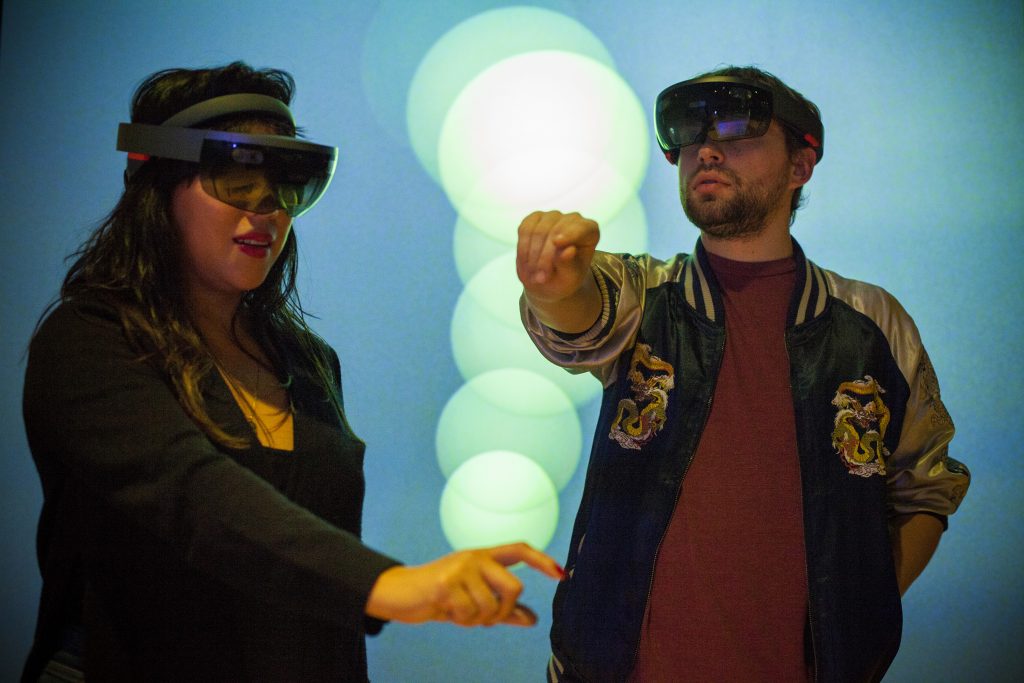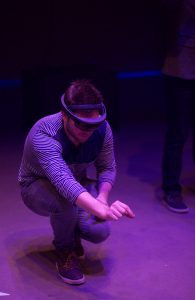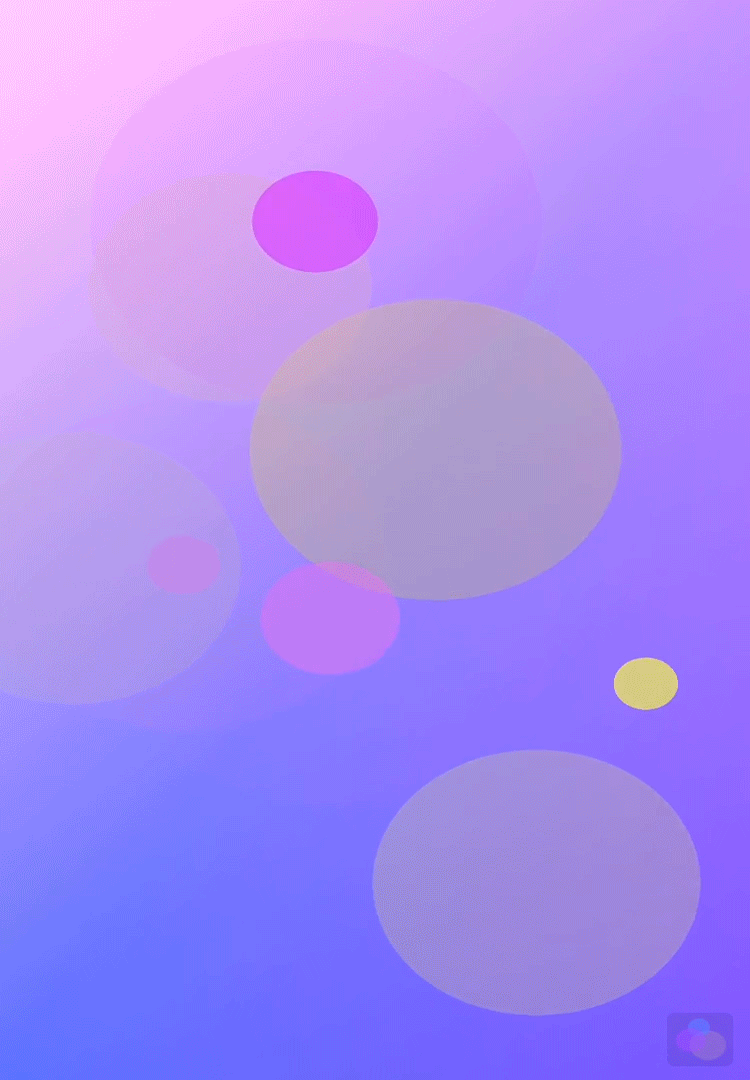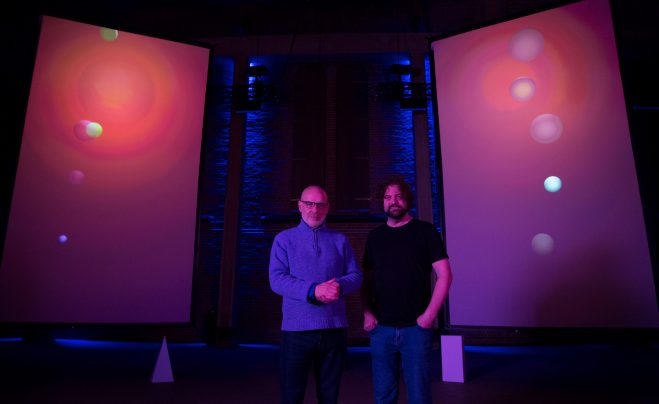
Brian Eno and Peter Chilvers create ‘quite magical’ flower garden of sound in Amsterdam with ‘Bloom: Open Space’
Brian Eno has spent his whole life willing technology to catch up to the creative visions in his head.
The Englishman, who calls himself a “non-musician,” has composed and produced more than two dozen of his own albums, not to mention dozens more collaborations with artists as diverse as Devo and David Bowie. He’s not a technologist, yet technology has been integral to his creativity since the ‘60s, when he developed a tape-delay system that inspired a whole new genre of music.
Now, he’s on to another tech iteration: This week, he and longtime collaborator Peter Chilvers are inviting the public to wander with them through a holographic garden of colorful, blooming sound bubbles, in an experience that blurs the line between audience and artist. “Bloom: Open Space” opened in Amsterdam yesterday, bringing the duo’s popular “Bloom” app into the 3D world with the aid of Microsoft HoloLens devices that allow visitors to be listeners, viewers, composers and creators, all at once, in a communal experience that’s the first of its kind.
Eno says he’s always been interested in the possibilities new technologies offer, and particularly “things nobody ever thought of doing before.” By expanding the HoloLens platform into the music and art world, he’s helping to free creativity from the constraints of reality and enabling people to join in creating visual music, regardless of their musical or artistic training.
On the Bloom app, users tap the screen to create colorful spheres that are also audible notes. Both the circle and the sound expand – or bloom – until they disappear, randomly joining with other blooms generated by both the user and the software to create wind chime-like, ambient music over a background of beautiful bubbles.
“Bloom: Open Space” converts that experience into something that’s physical, sensory and all-encompassing.
Ten to 15 participants at a time can don HoloLens headsets that are networked to each other to share sights and sounds. They then enter an inner circle, where they use their thumb and forefinger to pinch 3D blooms into existence, anywhere and as many as they want. Everyone gets a different color and tone for their blooms, producing a sound garden of bubbles and notes that float up as they expand. Dozens more visitors can gather in a ring around them, absorbing the same experience in a 2D fashion through floor-to-ceiling screens and speakers.
Much like the app’s generative music, whose strains never repeat, the visual music made during “Bloom: Open Space” must be experienced in-person. The pieces won’t be recorded and can never be replicated.
It’s the first time Eno has created an installation where the audience directly participates and becomes part of the experience, instead of just listening or watching. He’s hoping it will encourage visitors to slow down and take their time.
People using the Bloom app for the first time often start tapping away as if they’re performing a keyboard piece, Eno and Chilvers say. It can take five or 10 minutes before they realize the piece itself is actively responding to what they’re doing, and then they step back, move into a slower gear and start truly listening and realizing the enjoyment of letting the piece evolve with less of their input.
With the 3D element of HoloLens, “you’re not really listening to a piece, you’re walking through the piece,” Chilvers says. “It’s a way to turn a piece of music into an environment, which is a very different way of understanding it. It taps into the brain in a way that’s different than if you put headphones on.”
It’s the kind of relationship we’ll increasingly have in the future as systems become smarter and more responsive, Eno adds.
The project showcases “the intersection of music and technology with an artist who has been a thought leader on this for his entire career,” says Amy Sorokas, director of brand partnerships for Microsoft. “Having Brian and Peter collaborate with us to use HoloLens to push the concepts they explore into mixed reality is a great moment for our Music x Technology program.”
It’s a way to turn a piece of music into an environment, which is a very different way of understanding it. It taps into the brain in a way that’s different than if you put headphones on.
Eno and Chilvers came up with the name “Bloom” over text messages a decade ago as Eno was traveling on a train across Europe and Chilvers was home in England. “We were trying to summarize what the app meant to us,” Chilvers says, “and it felt like perfume had some connection, because ambient music hangs in the air like a scent. And that led to flowers and blooming, which is what the spheres do as they expand.”
Bloom languished in tablet form until smartphones with touchscreens were developed and the pair were able to turn it into an iPhone app. Then it began appealing to “all manner of people,” Chilvers says. “Parents wrote that they were using it to help their children fall asleep. Frightened flyers started relying on it to ease their jitters. We’ve had emails from people caring for autistic children and dementia sufferers saying it helped them calm down and even communicate.”
Never content with established technology – “I’ve got all manner of gadgets and gizmos at home and am always experimenting,” Chilvers says – the creative duo began playing with virtual reality (VR) as soon as it became available. But since VR headsets need to be plugged in to elaborate equipment and used in specific spaces, they found them confining and isolating. The augmented reality (AR) option available with HoloLens offered a shared experience they say was just what they wanted to bring Bloom into the 3D world.

“There’s something quite magical about using Bloom with HoloLens, and tapping the air and experiencing these magical shapes and sounds that appear around you,” Chilvers says. “It’s like wandering through a flower garden. They really do look amazingly solid. You have to keep reminding yourself they’re not really there.”
The pair spent about six months developing their idea for “Bloom: Open Space” before giving it a trial run in a warehouse in New York in November, with various colleagues, friends and family. They discovered that people interacted and expressed their personalities in ways they hadn’t even imagined.
Some crouched alone in a corner, placing blooms contemplatively and marveling as the orbs and sounds floated up around and past them. Others collaborated, designing bouquets of each other’s colors and notes in various palettes and patterns. And still others ran around the warehouse like kids in a candy shop, splashing blooms about willy-nilly.
One photographer who’d been hired to capture pictures of the trial ended up losing himself in it, creating fields of blooms and walking through them.
“It will be interesting to see how complete strangers behave with each other in Amsterdam,” Chilvers said before the installation opened. “I can imagine a few relationships starting this way, to be honest.”
Devices that augment reality began as gaming applications but quickly morphed into useful tools for situations such as medical training, inspecting elevators and jet engines and even redesigning golf courses.
HoloLens offers an interactive experience, “not through a screen but literally surrounding you,” that is spatial, physical, sensory and communicative, says Nick Kamuda, the creative director for the HoloLens team. It’s a powerful way to bring one’s imagination to the real world where others can experience it, says Kamuda, whose background is in music and the fine arts.
“Any new platform suggests new possibilities — usually not ones for which the platform was specifically made,” Eno says. “Those are, to me, the interesting possibilities, the ideas that wouldn’t have come into being were it not for the platform.”
Music and tech always went hand in hand for Chilvers, whose mother was a computer programmer and pianist. He officially began combining the two in the ‘90s by composing soundtracks for computer games. That’s also how he met Eno – the pair created computer-generated music for Will Wright’s game, “Spore,” that changed depending on what was happening between the player and the game.
Chilvers says he’s used to “banging my head against the wall for months” while learning how various new technologies work and pondering how they might pair with music. But with HoloLens, the cross-platform Unity 3D game engine does all the heavy lifting, so “now I’ve gotten to be much more creative and less technical, which I love.”
Patrick Sebring, who manages the design prototyping team for Windows Mixed Reality, says it only took half an hour to get Eno’s and Chilvers’ plan implemented onto a HoloLens device. “They were able to take our open-source examples and create an incredible immersive experience,” Sebring says. “The brilliance of this project is its collaborative nature and simplistic beauty. The whole experience is a great use of the technology.”
AR devices such as HoloLens are about technology and computers stepping into the human world, instead of forcing people to step into the computer world, says Chilvers.
“It’s untethered and unique, and it’s creating a new channel in how to imagine art,” he says. “There’s all sorts of experiences we’ve never thought of before. We’re only beginning to scratch the surface of possibilities for music and technology.”
Lead photo: Visitors to “Bloom: Open Space” don HoloLens headsets and “pinch” 3D blooms into existence, creating a colorful sound garden of bubbles and tones. (Photo by Drew Reynolds)
GIF footage courtesy of the “Bloom” app by Brian Eno and Peter Chilvers, available for iPhone.


















